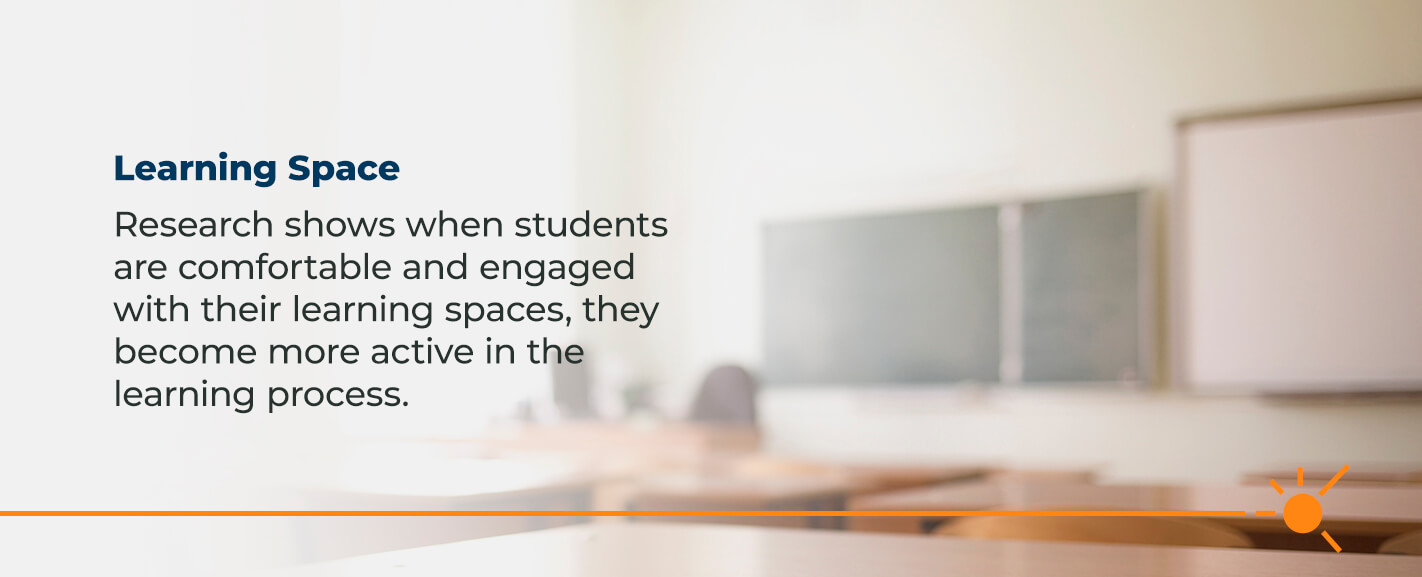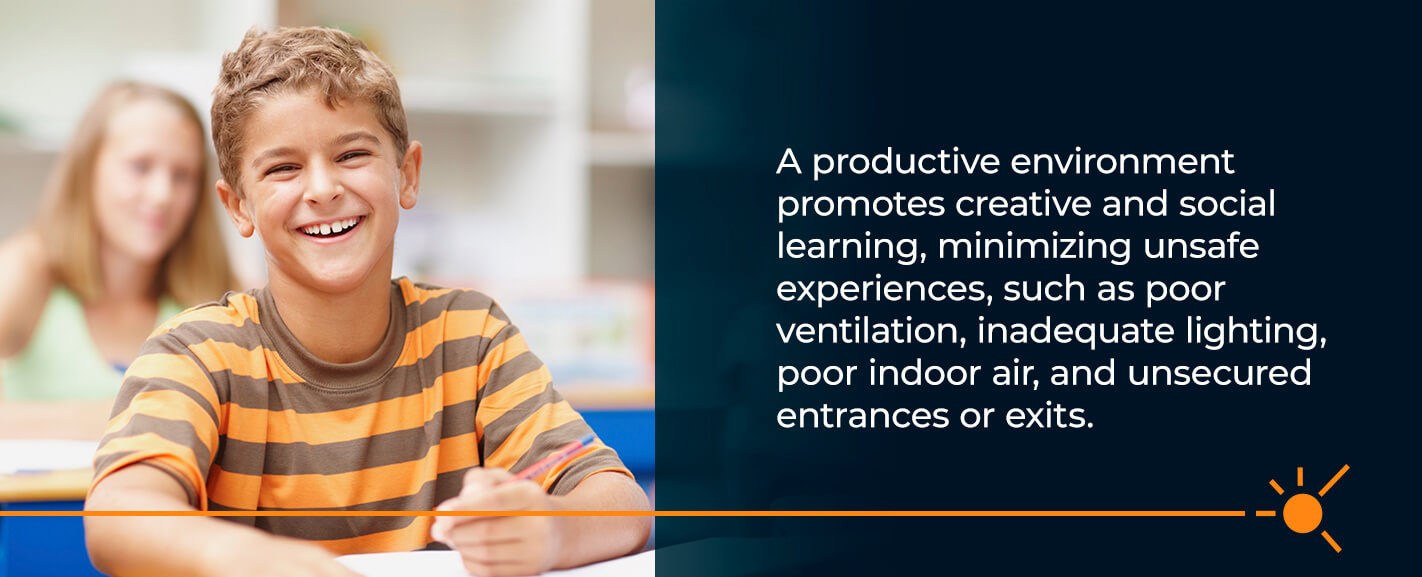
Schools help students develop life-long skills and create a foundation of knowledge that will help them succeed in adulthood. Today’s students are learning differently, and teacher instruction has had to adapt to meet ever-changing needs. It is critical that schools continue to adapt to these changes and recognize the importance of adopting collaborative learning and technology solutions to prepare students for their futures.
Future-ready education environments are designed to facilitate critical thinking, creative problem solving, collaboration, and communication. These spaces allow students to gain new skills and sharpen existing ones.
What Is a Future-Ready Learning Environment?
Future-forward schools foster a personalized, flexible approach to education — with robust technology — to better prepare a student’s fundamental attributes and proficiencies. This framework replaces a traditional model with innovative approaches, providing children with the tools they need to be successful and resilient individuals. A fundamental aspect of this framework allows children to develop core skills, including numeracy, literacy, and science.
Additionally, future-forward schools focus on developing technological, civic, and cultural literacy, helping children understand the world around them. K-12 school future readiness also places a strong foundation on critical thinking, collaboration, and communication skills to help students learn how to solve problems productively.
Future-ready classroom design helps educators prepare students with the ability and passion to succeed. Traditional classrooms continue to evolve into collaborative zones, providing immersive educational environments to keep teachers and students productive and engaged. Design solutions emphasize goal setting and providing personalized instruction for students. These design solutions also include sustainable models for equitable and flexible learning opportunities for each student. Design solutions emphasize goal setting and providing personalized instruction for students. These design solutions also involve implementing sustainable models for equitable and flexible learning opportunities for each student.
A future-ready environment prepares students to succeed in a technology-driven world that will require them to be problem-solvers, creative thinkers, and have the cognitive flexibility and emotional intelligence that is expected to help answer tomorrow’s questions. They also create deeper educational experiences for students while providing them with opportunities to apply their skills in real-life situations. As the learning landscape evolves, facilities must adapt to enable effective instruction and flexible learning experiences.

How to Transform K-12 Facilities
Traditional classrooms are arranged in a one-to-many layout, with students in their assigned space and the teacher spending much of the time in the front of the room. Modern classrooms are more dynamic and flexible in design. Based on the curriculum, learning style, and group interaction, the classroom space can be reconfigured as needed. Students are more engaged, and teachers act as facilitators, moving throughout the entire room as needed.

Research continues to highlight flexible classrooms as a way to promote quality education. For today’s learners, K-12 facilities must foster a productive environment by creating an actionable development plan:
- Identify the skills on which to focus. School leaders should consider beginning the process by determining critical skills that students will need to succeed and assess the current curriculum. At this point, actionable and measurable goals can be created to act as the framework for the path moving forward.
- Assess current facility conditions. Now that you know what and how you want students to learn, do the existing spaces in the school support the educational goals? If not, can the spaces be reconfigured to provide the atmosphere needed? Since technology is integral to class curriculums, does the school have the infrastructure needed to support (and protect) the devices it houses? This may sound daunting, but with the advent of mobile devices, space may be something that may be easier to manage than in the past. Computer labs can now become classrooms, for example.
- Create a development plan: Teachers will need to be the students at this point in the process. An important aspect of transforming how teachers facilitate instruction means equipping your team with the tools and training needed to succeed. All outcomes and teaching structures should map the result of student-led learning.
- Provide equitable access to resources and technology: All students require equal access to resources, information, and technology to achieve their full potential. Technology continues to become pivotal for students, allowing them to cultivate additional skills and access many online resources for learning.
What a Future-Ready K-12 School Looks Like
No two schools should look the same. Before implementing a development plan, it is essential to identify what a future-ready environment looks like for your community. By understanding the unique needs in your community, you can begin thinking about the district’s strengths, weaknesses, and areas that need to be transformed or reconfigured to foster critical interaction and educational needs.
One of the most fundamental aspects of an effective future-forward environment is providing research-based learning strategies to help students achieve their full potential. While each environment is unique, many of them share similar characteristics.
Common elements of progressive and productive future-ready school districts include:
1. Safe/Accessible Outdoor Play
Outdoor spaces provide additional opportunities for intentional learning activities, communication, and creativity. Imaginative, interactive activities can increase student interest and concentration, getting them ready to learn. Students are often more attentive and engaged following an outdoor lesson.
Of course, outdoor play still requires structure to be accessible and safe. While outdoor recreation is about creativity and fun, it can also help students achieve school-related goals. Students also gain valuable communication and teamwork skills with outdoor play.
Students can learn the importance of working with others, communicating, and building meaningful relationships. Social and emotional skills are pivotal for students. These qualities will grow with them, translating into tangible, valuable tools in the workforce.
2. Learning Space

The functionality, health, and comfort of a learning space can play an important role in students’ success. The freedom of choice within an environment can also promote efficient and engaging learning. If students are provided with structured options of how or where they work, they are often more likely to feel inspired and engaged. Your facility can offer students various working environments, seating styles, and more to engage learners.
Comfort also plays a vital role in the learning process. While it may be easily overlooked, discomfort caused by poor air quality, lighting, temperature, and classroom layout can distract from a child’s ability to focus and learn. When students are comfortable in their surroundings, they are also more likely to focus on the work or task at hand, minimizing potential distractions like repositioning or finding a more suitable location.
Research shows when students are comfortable and engaged with their learning spaces, they become more active in the learning process. It is also helpful when a classroom fosters a range of teaching methods, student needs, and learning activities.
3. Learning Technology
Technology can accelerate learning, providing students with unique opportunities and easy-to-access information. Districts should focus on technologies that most benefit students and teachers, including the infrastructure this equipment needs. Schools should keep connectivity ports, electrical outlets, and other infrastructure elements in mind.
An optimal environment enables children to access and recharge technology anywhere in the room for undisrupted learning. While learning technology is important to students, teachers can also experience many benefits from technology, including providing more detailed and alternative instruction and faster feedback.
Since technology is essential to productive learning, students and teachers need the resources to ensure they gain the competencies required to leverage the hardware and software. This is particularly important with the advent of distance learning which is now part of the education landscape.
4. Learning Environment
While a classroom should prioritize the teacher-student relationship, learning is also a social activity. A future-ready facility should foster positive interaction and teamwork between students, teachers, and peers. An ideal learning space allows students to work both independently and collaboratively.
One way to promote this learning style is to use versatile furniture, such as mobile tables or desks that can be arranged for flexible group sizes. Moveable partitions can expand and contract classrooms and common areas to accommodate school and community activities.
Creative materials and design elements encourage exploration and help students understand the connection between work and achievement. Learning should be fun and today’s evolving educational approach is proving that to students.
5. Safe and Secure Environment
Finally, a classroom must be safe and secure, allowing teachers and students to focus on learning. While we may initially think of public safety, which is paramount, a safe and secure learning environment also means access to healthy water sources, clean air, or brightly lit public spaces.

A productive environment promotes creative and social learning, minimizing unsafe experiences, such as poor ventilation, inadequate lighting, poor indoor air, and unsecured entrances or exits. These experiences can harm students and distract them from their education. If basic safety requirements are not met, students will feel uncomfortable, less engaged, and unmotivated to show up to class.
Security isn’t limited to classroom conditions. Today, digital safety is a vital aspect of any plan. Teachers and students alike should have the training and resources needed to safely use technology and the internet. A student’s digital safety is just as important as physical and emotional safety.
SitelogIQ Future Forward Design
At SitelogIQ, our team of experts partners with clients in K-12 public and private schools to foster a positive learning environment and ensure each facility can provide students with future-ready opportunities and equity in education. Over several decades, we have teamed with many school districts throughout the country to create equitable, functional, efficient, comfortable, and forward-thinking classrooms.

Our team understands each school district is unique and requires a customized solution to help their facilities meet educational goals while remaining within budget. Our comprehensive analysis includes but is not limited to:
Enrollment, Capacity, District Boundaries, and Grade Configuration
We work directly with K-12 administrative teams to create and implement various project plans to promote efficiency and high-performance levels in learning facilities. Our team can help a facility use innovative technology, maximize the utility of its space, account for safety, and provide in-depth training to facility management.
One of the first aspects of our comprehensive analysis is to assess enrollment, capacity, school district boundaries, and grade configuration to find any area for improvement. We help administrators assess current and projected district information so decisions can be made about short- and long-term needs.
As an example, some districts may be facing declining enrollment, so they don’t need to build another school. Instead, they may decide to reconfigure existing space and revise their curriculum to better match the types of careers available for students in their region.
Student and Community Activities
Next, our team can assess student and community activities. Often, schools are the heart of the community and many of the facilities serve as community resources. Research indicates many social and academic benefits of student and community activities.
Students who regularly participate in activities are often more motivated and likely to achieve higher grades. These students are also less likely to drop out of school or experience severe disciplinary problems. The benefits of student activities may even be more significant for at-risk or unmotivated students.
Community Use and Multi-Functional Capabilities
School districts continue to realize the importance of converting schools into multi-functional community centers with numerous capabilities by expanding their functions. Learning facilities are also reconsidering their role within local communities and ensuring their space is multi-faceted and functional. Some districts may even realize a new revenue stream when they create spaces to host events and activities.
Programming Changes
Finally, our team will assess your current programs and recommend potential changes. Efficient programming changes allow your facility to maximize its functionality and increase student engagement.
K-12 students benefit from collaborative programs and flexible learning spaces that resemble studios or workplaces rather than traditional classrooms. Altering the physical environment and programming can provide students with the flexibility to support future-ready learning.
SitelogIQ Recent Projects
At SitelogIQ, we are a team of designers, analysts, engineers, former educators, planners, and project managers dedicated to improving schools. We offer a unique set of experiences, skills, and backgrounds that allow us to deliver the highest level of service and exceptional outcomes for clients. We consider the education, physical, and financial impact of any facility improvement measure so our recommendations positively impact the learning environment.
We do not work in a vacuum. Our clients are actively involved in the process. The school leaders, staff, students, and community members know their district better than we ever will. What makes us different is that we listen. We don’t offer the same solution to every district because every community is unique. We collaborate to design and implement plans tailored to each district’s needs.
Some of our recent projects included:
- Learner-based communication labs: The more students focus on their screens, the more likely they struggle with communication. In the lab, students practice activities including public speaking, presentations, small group interaction, practice interviews, and roleplaying. These skills are vital for both personal and professional growth.
- Future-ready career and technical education (CTE) areas: CTE helps prepare students for college or work. Unlike vocational training in the past, the scope of CTE is much broader and allows students to learn new skills as they investigate potential career paths. While many CTE students move on to some sort of post-secondary education, other students who choose to move right into a career are equipped with a set of marketable workplace skills. Since CTE can include extensive career options, our experts can help districts determine those to include in their curriculums, typically based on the needs of the regional job market.
- STEM laboratories: This hands-on, problem-based education is meant to help students become innovative and critical thinkers. What they learn gives them the ability to solve real-world problems. Like CTE, STEM helps students explore and build skills that will benefit them throughout their lives. We can create custom solutions and unique approaches to find the space and equipment required based on the available budget.
- Flexible teaching spaces in common areas and cafeterias: With school space at a premium, we can help turn underused areas into functional, flexible spaces. Some schools have wasted space in hallways that can be converted into break-out spaces for nearby classrooms or individual study areas. Cafeterias can be designed with movable walls, chairs, and tables, so they can become dining areas, classrooms, or large meeting spaces. Public use of school facilities seems to be increasing and districts can leverage this need by renting spaces, further maximizing facility occupancy.
- Future-ready media and library spaces: Libraries, once quiet research destinations, are turning into library media centers that can act as student study and collaboration spaces during the day and host board meetings after hours. Many libraries become the focal point of the school and are busy the entire day, partly because they’re designed with a coffee house feel to be warm and welcoming. Since there are many different styles of learning, the space should reflect this variety. Our team can help blend the technology needed in this dynamic space with a flexible configuration to accommodate everything from individual study pods to large group seating.
- Alternative funding opportunities: Funding and financing options are essential aspects of all projects. We help facilities find funding options for their specific projects or needs, including alternative funding opportunities to implement projects with little to no upfront expenses. For example, many districts benefit from a comprehensive energy audit. By implementing improvements that have the greatest return on investment, districts can significantly reduce energy costs and redirect those funds to student-centered initiatives.
Efficiency Powered by Intelligence
SitelogIQ is a full-service facility planning and energy efficiency company that creates, improves, and maintains healthy and safe working spaces, learning environments, and multi-unit living spaces. Our experts provide comprehensive knowledge of all aspects of facility design, planning, and management.

We provide comprehensive facility solutions that support energy-saving, future-proofing, and sustainability goals. Some of our most popular solutions include consulting and planning, commissioning, and lighting and technology controls. We are proud to serve many markets, including the federal government, healthcare field, higher education, and more.
Contact us to learn more about our solutions or call us at 888.819.0041 for assistance.


